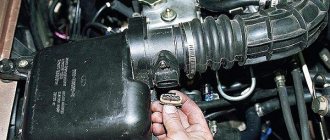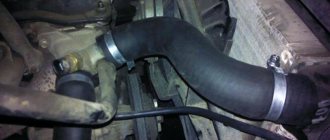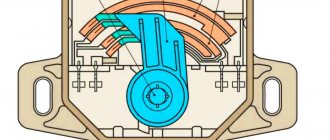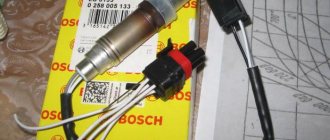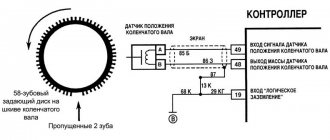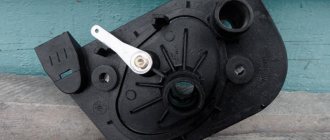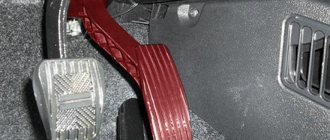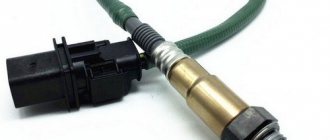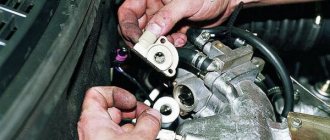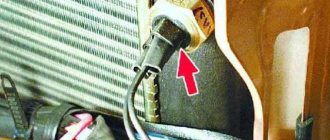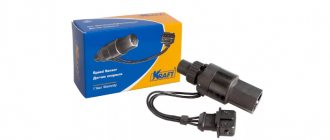MAF (mass air flow sensor) - an element installed in a car engine that controls what temperature and mass of air enters it. The on-board computer “reads” this information and determines how much fuel is required for further operation of the engine. A dirty sensor can cause excessive fuel consumption, loss of power, stalling or transmission problems. Air flow sensor cleaner - a special tool, using which you can restore the normal operation of the sensor yourself.
What kind of device is this?
Such an element is present in any modern car, since the era of carburetor engines has passed and an electronic control unit (ECU), or controller in other words, is responsible for many operations. Many drivers even call him “the brain.”
The mass air flow sensor is used to measure the amount of air supplied to the engine. However, this device does not measure its volume, but only determines how much mass passes per unit of time, sending data to the ECU. In turn, the controller “understands” how much air has entered the cylinders at each moment of time, and depending on this, adjusts the fuel supply. As a result, the engine runs smoothly and without interruption.
Beginners may be interested not only in whether the mass air flow sensor can be cleaned, but, in fact, where it is located. Typically, this device is located in the area between the air filter housing and the pipe that goes to the throttle valve. It is equipped not only with gasoline, but also with diesel power units.
How to clean the mass air flow sensor
Before you begin, here are a few notes to be aware of:
- Some manufacturers recommend replacing the MAF rather than cleaning it if the hot wire or sensing elements are dirty because cleaning the wires will not restore the sensor to its original performance. However, cleaning a dirty MAF sensor may work fine in most cases.
- If your sensor is around 100,000 miles or more, you may want to consider a new replacement, especially if engine performance seems a little sluggish after cleaning.
Unlock the tab to disconnect the MAF electrical connector.
Now, if you are ready to start, make sure the ignition switch is in the "Off" position. Then set the parking brakes and open the hood.
- Disconnect the MAF electrical connector. Be careful. You may have to press down on a plastic tab or latch to release the connector.
- Remove the bolts, usually two, that hold the sensor in place. On some models it is located inside the air filter box. If necessary, consult your vehicle's repair manual.
- Remove the sensor from the air intake trunk lid or air filter box.
- Check the rubber gasket that seals the MAF to its housing. If damaged, replace it.
- Do a visual inspection. Check the sensor for overheating and, if installed, cold wires for traces of dust, dirt, debris or insects.
- Place the MAF on a workbench or similar surface and leave it on the rag. The rag will help you catch the cleaning solution runoff as you spray the sensor.
- Wear safety glasses and latex gloves.
- Clean the sensor by spraying it with cleaning solution. Follow the instructions included with your product. Whatever you do, avoid touching sensitive wires. They are fragile and can break easily.
- If the hot and cold wires are covered in dirt or debris, you can use a brush to wipe them off.
- Spray a small amount of sensor cleaning solution into a small, clean cup.
- Soak a small brush in the cleaning solution.
- Use a brush to remove dirt and debris from the wire(s).
- After cleaning the MAF, allow it to dry completely for a few minutes.
- Meanwhile, remove dust and debris from the air filter housing and air ducts. If there is dirt or debris in the ducts, the unit forces air through the air filter.
- Install the air filter correctly and close the air filter box and air duct.
- Install the MAF, make sure the rubber seal is installed correctly, and secure the sensor with the mounting bolts.
- Connect the MAF electrical connector. Make sure the tab is locked.
- If necessary, clear fault codes using a scan tool.
- Start the engine and listen to it at idle speed.
Depending on your specific model and the trouble codes set in your computer's diagnostic memory, you may need to drive several miles to improve engine performance. For example, you may still notice a rough idle. The ECM (Engine Control Module) may take some time to adjust to the new input parameters.
If cleaning does not solve your engine's performance problems and you suspect a problem with the sensor, you may want to check the MAF sensor or replace it.
A couple of recommendations:
- If you find dirt or debris attached to the wires or sensing elements, this may indicate a faulty self-cleaning circuit. You can test the "off" relay and, if necessary, the circuit. Refer to your vehicle's repair manual.
- Some manufacturers recommend replacing the air filter after cleaning the MAF.
Securely secure the clamps of the air filter assembly to prevent air leakage.
When is it time to clean?
But regardless of the type of sensor, over time it begins to function incorrectly due to contamination - the platinum measuring elements become covered with dust. Therefore, the question of how to clean the mass air flow sensor will always be relevant.
Why does this happen? The main reason for sensor contamination lies on the surface - the unsatisfactory condition of the air filter. If the filter element is of poor build quality, then it is not able to trap microscopic particles of dirt and dust that settle on the sensing element of the mass flow sensor.
As a result, the device is not able to accurately measure the amount of air and sends incorrect data to the ECU. It's not hard to imagine what this might lead to. Here we gradually approach some characteristic signs that may indicate that the sensor is clogged and needs to be cleaned:
- The need to clean the mass air flow sensor on a VAZ or other cars arises when the engine idles intermittently, in some cases they are too high - up to 1500.
- The car may jerk and have difficulty accelerating.
- Sometimes the engine does not start at all.
- Increased fuel consumption - sometimes up to 15 liters per 10 km.
- Check Engine light on the dashboard.
However, the above signs do not always accurately indicate contamination of the air flow sensor. A variety of situations can arise, and among them is one when the sensor itself is fine, but the fault lies in the hose that connects the device to the module.
In other words, although there are many obvious signs that a particular part of the car is faulty, they can indicate any other problem.
Reasons for failure of the mass flow sensor
Cleaning the mass air flow sensor is a responsible task, and once completed, the car may even start to drive better. But you need to understand what causes it to malfunction. A flow meter, which transmits important parameters, is important in order to use the amount of fuel that is needed for the normal functioning of the engine. If the element fails, the engine may not even start.
Symptoms of blockage:
- the “Check Engine” indicator lights up on the control panel;
- the car began to consume more fuel;
- There is a noticeable decrease in transport power. Acceleration takes longer than before;
- the dynamics have decreased, which is especially noticeable when accelerating;
- the engine does not start or does so only with difficulty;
- the crankshaft operates at “floating” speed.
Causes of malfunction:
- the sensor is clogged with dirt. The solution is to clean the air flow sensor;
- the device is broken. In this case, only replacement will help;
- the sensor began to have poor contact with the on-board network. The wiring may be damaged.
Of course, the reasons may be related to other components, which is why it is so important that the vehicle owner knows how to carry out diagnostics.
Sensor check
To accurately verify that the sensor is faulty and understand whether the mass air flow sensor on the VAZ-2114 needs to be cleaned or not, whether it needs cleaning or whether you will have to go to the store for a new mass air flow sensor, you will need a multimeter known to all radio amateurs:
- The device is switched to voltage measurement mode (voltmeter).
- Set the limit to 2 V.
- There are two wires in the sensor connector - yellow (it goes to the ECU) and green (connects to ground).
- The voltage is measured between these wires, and only the ignition should be turned on.
- Now all that remains is to look at the instrument readings.
If the measurement result is 0.99-0.02, the sensor is working. If the upper threshold is exceeded to 0.03, the mass air flow sensor needs cleaning and the sooner the better. In the case when the measurements are less than the lower limit (0.95) or the upper limit is very high (0.05), then the chances of a successful outcome are 50/50. That is, either cleaning will help and the sensor will function properly again, or you need to buy a new device.
In addition to this, you can understand whether to clean the mass air flow sensor on a VAZ-2110 or not by using one more method when you don’t have a multimeter at hand. Disconnect the sensor, then start the engine, raise the speed to 2000 and drive for a while. If at this moment there are obvious changes, the car has become more dynamic, then the sensor is definitely dirty.
Detailed repair instructions
All the details of the process of washing the engine and engine compartment of a car
In practice, with the help of cleaning, the functionality of most sensors can be restored. At the same time, the car owner saves money. If, when checking the mass air flow sensor, it turns out that the voltage readings do not correspond to the norm, then you need to dismantle the device and wash it.
It should be remembered that you cannot use a toothbrush or cotton swabs for cleaning, since mechanical contact with the sensitive elements of the sensor can cause serious harm. Alcohol must be diluted with water in a ratio of 5 to 1. In addition to the listed means, in some cases you may need a 10-20 cc syringe with a needle.
Removal and cleaning of the mass air flow sensor must be carried out in the following order:
First, disconnect the block with the power wires. To do this, you need to press the release button, which is located at the bottom of the device. Unscrew the screws securing the unit to the air filter housing. Unscrew the connecting elements of the protective casing, screws, and remove the sensor itself. The most sensitive parts of the device are the temperature sensor wire, contacts
They need to be washed with extreme caution. To wash the resistor, the aerosol tube must be inserted into the upper channel of the sensor to a depth of approximately 10 millimeters
The procedure itself is carried out several times with short breaks of a few seconds. Penetrating lubricant WD-40, “Hado” is applied for cleaning several times with breaks of 30-40 seconds. At the last stage, you need to let the device dry thoroughly. After this, the sensor is installed in place, and its voltage is checked using a tester. If all indications are normal, then the procedures performed can be considered successful. Otherwise, you will have to change the mass air flow sensor.
Thus, if the air flow sensor partially loses its functionality, you should not rush to purchase a new device. It is advisable to spend 15-20 minutes dismantling and cleaning the old device. This will restore its functions and help save money.
Cleaning products
Since the sensing element of the air flow sensor is made of platinum, therefore, it is necessary to choose the right means to clean it. And first of all, it’s worth understanding what you absolutely cannot use:
- Any liquid that contains acetone, ketone, ether.
- Products used to clean carburetors.
- Cotton wool wound around a match, toothpick, etc.
- Compressed air.
What then remains to be used? Well, there are plenty of options here too.
What is the best way to flush the air flow sensor?
In fact, there are not many cleaning compounds that can be used to clean the air sensor - all the others will simply ruin it (see section above).
Therefore, the question: what is the best way to flush the air flow sensor can be answered quite specifically:
- pure medical ethyl alcohol that does not contain any impurities;
- carburetor cleaner (does not contain acetone);
- spray WD-40.
WD-40
At the same time, medical alcohol can be used either 96 degrees or diluted with distilled water in a ratio of 1 to 5.
Liqui Moly
How to clean the MAF sensor? One option is cleaning fluid from Liqui Moly. The company is known to many car enthusiasts as a manufacturer that makes only high-quality products for cars. In addition, the ratio between reliability and price is at an optimal level. As for the use of liquid for cleaning the mass air flow sensor, most vehicle owners have already become convinced of its effectiveness. This has not been proven by a single procedure. And if the sensor is in working condition, then even after cleaning it will last no less.
The liquid can be used for both diesel and gasoline engines.
Routine cleaning work
The air flow sensor is cleaned every six months or when changing the oil. Experts also recommend cleaning the device when the air filters are changed. Replacing the sensor at service centers costs $300, but if you clean it regularly, you can avoid car repairs. For this purpose it is recommended to use special means. The MAF cleaner costs about $7. The cheapest option is to take the air flow sensor and place it in a plastic bag filled with alcohol or a special cleaning fluid. Necessary tools for the process:
- 4-in-1 screwdriver;
- digital camera;
- Torx tool;
- MAF cleaner.
After cleaning with cleaning agent or alcohol, allow the device to dry for 20 minutes. Only a completely dry air flow sensor can be installed in a vehicle. Algorithm for cleaning the device:
Before you go to the store for materials and parts, you need to remove the air duct to see how the sensor is attached. If it is held on by Torx screws, then you will need to purchase a Torx tool and a can of cleaner. It is not recommended to use other cleaning agents; they may damage the air flow sensor. Do not use the cleaner with the engine running and the key in the working position. This will cause serious damage to the sensor. With the engine turned off and cooling, disconnect the mass air flow sensor.
Locate the sensor between the air filter box and the throttle body
Before removing the sensor, you should use a digital camera to record settings and connections. Carefully remove the sensor from the air duct and disconnect the electrical connector. Then remove the air intake pipe and mass air flow sensor. Most sensors are connected to hose clamps, so you need to loosen the clamp and remove the device box. Place the air flow sensor on a dry towel. Spray the cleaner onto the inside of the body and the working element 10-15 times. When doing this, you need to be careful not to touch the wires, as they are quite thin. Spray the product onto the entire surface of the air flow sensor, including connectors and terminals. Install the sensor in the car and wait a few minutes before starting the engine until the chemicals evaporate.
Liqui Moly Cleanser
Liqui Moly is a special active solvent for cleaning the air flow sensor for all brands of engines. The cleaner removes contaminants on the hot wire or air flow sensor plate. Suitable for use in gasoline and diesel engines. The cleaning procedure is simple: you need to disconnect the electrical connection of the air flow sensor and remove it by spraying the solution on all dirty areas.
Multi-functional product WD-40
WD-40 is used to wash the sensor and metal surfaces of the car from rust and dirt. The cleaner penetrates boiling deposits, displaces moisture and lubricates almost everything. WD-40 is also great for removing grease, dirt, and other marks from most surfaces. It is an iconic multi-purpose product for general or spot applications.
WD-40 cleans and protects auto tools and mechanical equipment from rust and corrosion, removes grease, dirt, tar, rubber, scratches, water deposits, etc. It is able to penetrate deep into deposits, loosen rusty parts such as nuts, bolts , valves, locks, etc. WD-40 binds and displaces moisture from engines, spark plugs, power tools and vehicle fuel systems.
GDI fuel injector cleaner
Get Clean is a comprehensive cleaning fluid for engine and air sensors. The product is ideally formulated to restore performance, increase horsepower and torque, improve idling and reduce emissions for improved engine performance. Using this product helps to quickly and easily remove even the hardest deposits on the sensor.
If cleaning the air flow sensor with a cleaning solution does not solve the problem, then:
- The self-cleaning circuit may fail.
- Air leakage around the cleaning assembly bypasses the air filter.
- A low quality filter allows material to pass through and stick to the sensing element.
- An air leak around the air filter housing, caused by a crack, an improperly installed cap, or loose clamps, introduces unfiltered air and contaminates the sensing element.
The efficiency of the equipment after washing is guaranteed for 10 thousand km. Free sensor deposits mean optimal fuel system performance, which equates to improved engine performance, quick throttle response, smooth starting and fuel economy.
Alcohol
We can say that this is an old-fashioned method, which at the same time will never lose its relevance. Alcohol can effectively break down dirt and blockages. About 20 years ago, the question of how to clean the mass air flow sensor was mainly solved with the help of alcohol, and this method was held in high esteem by many drivers, but now they are trying to resort to it less and less.
Nevertheless, it is relevant in cases where the car owner needs to invoice for washing with special means. Unfortunately, such disappointing practice is not uncommon at many service stations.
Sensing element of the air flow sensor
The most common cause of sensor failure is a dirty element. To resolve the problem, it is recommended to check it. To do this, you need to disconnect the mass air flow sensor from the air filter assembly and visually inspect it. If the sensing element is dirty, it may be serviceable, but contamination introduces errors into the measurement mode. Sensor check:
- Identify the terminals on the MAF sensor itself that correspond to the signal wire and ground.
- Set the meter to the continuity or low setting on the ohm scale.
- Connect one measuring probe to the signal and the other to ground on the MAF electrical connector. Polarity doesn't matter.
- The indicator should be 0 Ohm or close to this value. If the device displays infinite resistance, most likely the mass air flow sensor element is faulty.
- Visually inspect the sensor.
Hot-wire sensors have a self-cleaning electrical circuit that heats the sensing element to 1,000 degrees when the engine is turned off. This part of the circuit often fails; the mass air flow sensor becomes covered with dirt and does not read the incoming air. In this case, you can try to clean the sensitive element using a special spray. In this case, safety precautions must be observed. Do not touch the sensitive element or clean it with a cloth or special means not intended for mass air flow sensors or electrical contacts.
WD-40
Absolutely every car enthusiast is familiar with this product, regardless of experience. In addition, all other people who are not directly related to cars know about it. Over the course of its existence, WD-40 has proven itself to be excellent, and there is no doubt about its effectiveness.
For this reason, it is used not only to remove “deposits” from bolts, but also to clean the mass air flow sensor.
How to check the air sensor yourself
So, if the driver exhibits the signs discussed above, then the sensor needs to be checked. By the way, it is important to understand that the symptoms of a malfunction of the VAZ 2114 DMVR can be very similar to the symptoms of malfunctions of other components of the car. For this reason, before starting repair work, diagnostics are necessary.
To do this, you need to know how to check the mass air flow sensor on a VAZ 2114. Let us immediately note that this can be done with a multimeter. To check the mass air flow sensor, you do not need to go to a service station; it is enough to purchase a regular tester (multimeter) and know the pinout of the contact group.
DMRV pinout:
- contact “5” - supplying an incoming signal from the electronic control unit (yellow wire);
- pin “4” - power supply to the device (gray or white wire);
- contact “3” - grounding (green wire);
- contact “2” - transfer of information from the sensor to the main relay (pink-black wire).
To check the VAZ 2114 mass air flow sensor using a multimeter, do the following:
- Set the multimeter to DC measurement mode up to 20 V.
- connect the red wire from the multimeter to pin “5”, and the black wire to pin “3”;
- Turn the ignition on without starting the car and look at the multimeter readings.
Decoding multimeter readings:
Then, based on the indications, appropriate repair work is carried out. In some cases, you can limit yourself to cleaning, checking contacts, etc. Others will require a complete replacement with a new device.
How to properly clean the air flow sensor
Let's consider the procedure for cleaning the mass air flow sensor using the example of a car of the 10th family - VAZ-2110:
- Turn off the ignition.
- Disconnect the connector from the mass air flow sensor.
- Remove the sensor itself by unscrewing the bolts that secure it to the air filter housing. Depending on the car model, disabling the mass air flow sensor may vary.
- The sensor is removed from its place, otherwise its cleaning will not be effective.
- On the device itself there is an area with two bolts - these should also be unscrewed.
- The selected cleaning agent is drawn into a syringe and then sprayed onto the sensitive element. At the same time, if necessary, you can wash the block with contacts.
- Give time for everything to dry.
- Assemble the sensor and install it in place.
To make drying faster, you can use a compressor only at minimum pressure. If the sensitive element is heavily soiled, the procedure should be repeated several times.
But even in this case, washing does not always give the desired result, and you just have to go to the nearest store for a new mass air flow sensor.
Cleaning the air flow sensor on a VAZ.
For the so-called repair of the mass air flow sensor we will need:
- cleaning and rinsing liquids;
- syringe;
- flat screwdriver.
- We remove the mass air flow sensor. To find out how to remove the mass air flow sensor, read the article How to replace the mass air flow sensor?
- We unscrew the sensor element, which is attached to two special bolts. Such bolts can be unscrewed with a regular flat-head screwdriver.
- We take a syringe with liquid and at a distance of 5-10cm. spray on all parts of the sensor: contacts, diode, holes, etc.
- For prevention, we clean the wire connection block and their contacts.
- We rinse everything with the same syringe and let it dry.
- We install and check.
- If it does not help, then the process can be repeated again. If the sensor still does not work, you will have to buy a new one.
Additional manipulations
It is now clear how to clean the mass air flow sensor, but this procedure alone does not end everything; it is necessary to perform a number of additional and necessary manipulations. And you need to do this before installing a clean device. And while the cleaning agent is drying, it’s time to work on the air pipe. It is worth carefully inspecting it for integrity. And if the condition is unsatisfactory - there are cracks and other damage, then it should be replaced.
As experts note, before installing the mass air flow sensor, it is advisable to replace the filter element. You should also check the condition of the rubber seal. Here it is important to pay attention to how tightly it fits, otherwise it will not be possible to avoid the suction of outside air, which is flooded with various contaminants. As a result, cleaning will be required again, and in a fairly short time. Or it will lead to its failure altogether.
Video “Cleaning the air flow sensor”
The easiest way to consider cleaning the mass air flow sensor is using the example of a VAZ 2110 car. To return the air flow sensor to its former functionality, you must first turn off the ignition and disconnect the connector from the regulator. Unscrew the bolts (or 1 bolt) securing the air flow sensor to the air filter housing with a wrench and remove the pipe.
To quickly remove the mass air flow sensor, you will need a star key of the appropriate size.
Sometimes you can find oil deposits on the device; you can use any of the means described above to remove it. If finances allow, buy liquid from Liqui Moly, but if you don’t have money, you can also use carburetor cleaning products. After this, look inside the removed device, you will see several sensors in the form of a wire, fixed with a special resin.
A special Liqui Moly cleaner or carburetor cleaner should be carefully sprayed onto these sensitive components. Be careful not to damage the film. After this, wait until the cleaning agent dries completely and evaporates. If contamination remains, the procedure can be repeated several more times.
We invite you to read: How to smooth out the leather on a jacket... Remove wrinkles at home
When you start cleaning the regulator yourself, you should also pay attention to the air filter hose mesh and its internal surfaces. They, as well as the air flow sensor pipe, can also be cleaned
The pipe sometimes needs to be replaced if, upon visual inspection, you find traces of mechanical damage, cracks and other defects.
This completes sensor cleaning. All you have to do is install the device back. When performing this work, you can replace the filter elements; experts assure that this can significantly improve the operation of the unit.
Cleaning the flow meter can be done in a garage; there is nothing complicated about it.
Depending on the car model, the procedure for removing the sensor can be carried out in different ways; consider an example of cleaning with a domestic “Ten”:
First, you should turn off the ignition and, just in case, reset the battery terminal. Open the hood and find the mass air flow sensor, then disconnect the connector from it. There is a pipe connected to the flow meter; it must be disconnected. Using a wrench, you need to unscrew the screw that secures the device to the air filter, or rather, to its housing. The flow meter itself is removed from the corrugation; in the case of the “ten”, an asterisk wrench is required to dismantle the sensor. Use it to unscrew the screws and then remove the device from the seat. If, after removal, you notice that there is an oil deposit on the device, you will need to rid the case of this. Any product from those described above is suitable for cleansing. As practice shows, there is no fundamental difference between these means. On the sensitive element, usually made in the form of a film, there are several controllers, they are made in the form of a wire and mounted on resin
Using the same cleaning agent, you will need to carefully, not in abundance, spray it on the sensitive element. At this stage you should act with extreme caution, as there is a possibility of damage to the film.
After the sensitive part has been treated, you need to wait a little until the product takes effect. If there is a lot of contamination, then it may make sense to repeat this procedure once or twice. In order to ensure faster evaporation of the substance, you can use a pump or compressor device. But keep in mind that too much pressure can destroy the sensitive component, so don't overdo it.
Price issue
The cost of Liqui Moly cleanser is currently about 700 rubles. A cheaper analogue, liquid for cleaning carburetors, will cost the buyer about 70-100 rubles. As for WD-40, the cost of a 100 ml can today will be approximately 180-220 rubles.
Purifier selection options
How to clean the flow meter? The modern market offers many products for cleaning regulators; let’s look at the most effective options:
- Alternatively, you can use alcohol to clean the device. This method is considered one of the oldest, but nevertheless the most effective. Due to its chemical properties, alcohol is good at removing clogs that accumulate on the sensitive component of the air flow sensor. Despite its effectiveness, today this method is not used so often and is usually used by unscrupulous technicians at service stations. The client pays for a special substance, for example, Liqui Moly, and in fact the cleaning is carried out using alcohol.
- The next option is fluid for carburetor engines. This option is considered one of the most effective and frequently used. Using carburetor fluid, you can effectively clean it, and as practice shows, such a product allows you to remove all contaminants.
- Another product sold in spray form is Liquid Key. This cleaner is used to remove all kinds of contaminants, not only from the flow meter, but also from other mechanisms and components.
- A universal tool for performing many tasks is WD-40. This liquid is used by our compatriots to clean all kinds of components, remove rust, get rid of squeaks, etc. Not so long ago, our car enthusiasts began to use it to clean flow meters (the author of the video is the Gen channel MB W140 Germany).
How to turn it off if you have a key fob
There are two options for disabling the security mode using the remote control - standard and silent.
Standard method
You can turn off the Tomahawk alarm on your car using the remote control like this:
- The second button on the key fob is pressed; number 2 indicates controls with an indicator in the form of an open lock.
- The siren will emit a short beep and the emergency lights will go off.
- The door locks will be unlocked. External lights should turn off. The key fob may emit a confirmation beep and a symbol in the form of an open lock will appear on its screen.
Silent shutdown
The security system will be turned off in silent mode without confirmation sounds. Only external lighting devices connected to the anti-theft system are activated.
To disarm a car, you need to do the following:
- On the key fob, first press button 1, and then immediately control element 2. The vehicle's headlights will blink twice, the siren will not work.
- The car doors are unlocked. An icon in the form of an open lock will appear on the remote control screen.
Disabling the autostart system
If you need to disable this option, do the following:
- On the communicator, press a key with an indicator in the form of an open lock and key. This control must be held for two seconds until a melodic signal appears.
- The key with the locked lock “clicks” briefly.
Features of turning off a remotely started engine on X5 alarms:
- A key in the form of an open lock is pressed on the remote control. The button is held for several seconds until the communicator beeps.
- Within 3 seconds after the device is triggered, the button with the open lock “clicks” briefly, without being held down. The power unit should shut down and the alarm status will appear on the pager display.
Video: disabling the autostart system
User Ivan Vasilyevich in his video explained in detail how to set up the automatic engine start system and what you need to know about turning it off.
How to turn off the alarm
It is advisable to turn on the alarm when the engine starts automatically, but if you want to disable the option, perform the following steps:
- On the communicator, press the button with the “F” indicator. This key must be held down for five seconds. The device will play a sound pulse and the clock indicator will begin to blink on its screen.
- The "F" button is pressed four times.
- Then the key in the form of a crossed out speaker is “clicked”. An icon with the word “Off” should appear on the key fob screen.
- The “F” button is pressed for five seconds. This will deactivate the alarm.
Designation of control elements on communicators of different Tomahawk models.
Removing and washing the mass air flow sensor.
To remove contaminants on all working elements of the sensor, it can be washed. But to do this, it must first be removed.
Remove it from the car with the body, and carry out further disassembly in more convenient conditions.
First, disconnect the sensor connector. Be careful and careful: the connector has a latch and is quite difficult to pull out, especially for the first time.
The main and most difficult task is to remove the sensor itself from the housing. It is secured with very tricky star bolts and not every car enthusiast has such keys in their arsenal. Therefore, in the absence of “stars”, pliers are used. The main thing is that they have unrolled internal teeth and engage well with the bolt head.
The sensor fits tightly and tightly. Pull it out carefully so as not to damage the temperature resistor on the case when removing it. Otherwise, you will definitely have to run to the store.
Use a screwdriver to slightly pry/move it from its place and pull the sensor towards you with swaying movements, holding it with your other hand, acting as a guide and keeping it from swinging excessively from side to side.
Important! Never touch the platinum wire and the thermistor with your fingers! There is no question of any cotton swabs, napkins, gauze or any physical contact with them during cleaning!
We clean the sensor only with special cleaning agents in aerosol cans. Their price ranges from 150 rubles for domestic production to 800 for imported ones. It's up to you to decide which one to use. Even an expensive product is much cheaper than a new sensor.
You can also wash it with pure alcohol, spraying the sensor with a small stream from a syringe. It copes with the task quite well (90 percent), but I still recommend using special tools designed for this. Their composition and action are much more effective.
Before rinsing/spraying from the can, check that the spray of the product is not too strong. The more powerful the pressure, the farther from the sensor you remove the aerosol. Our goal is to completely soak the sensor with liquid to break down contaminants, not to knock dirt off it.
Thoroughly spray the sensor, all its bends, holes, internal and external working surfaces. Give the liquid about a minute to interact with the contaminants. Then repeat the procedure and wait about the same time.
And finally, we do the third, control spraying - as if washing off the dirt with a dissolved product. After this, let the sensor dry completely for about 10-15 minutes and safely place it in the case and install it on the car.
PS It is recommended to clean the mass air flow sensor when you are sure that interruptions in engine operation are associated precisely with its malfunction and possible further replacement. Perhaps it really just got dirty and this procedure will correct the situation and help avoid unnecessary costs.
Source
